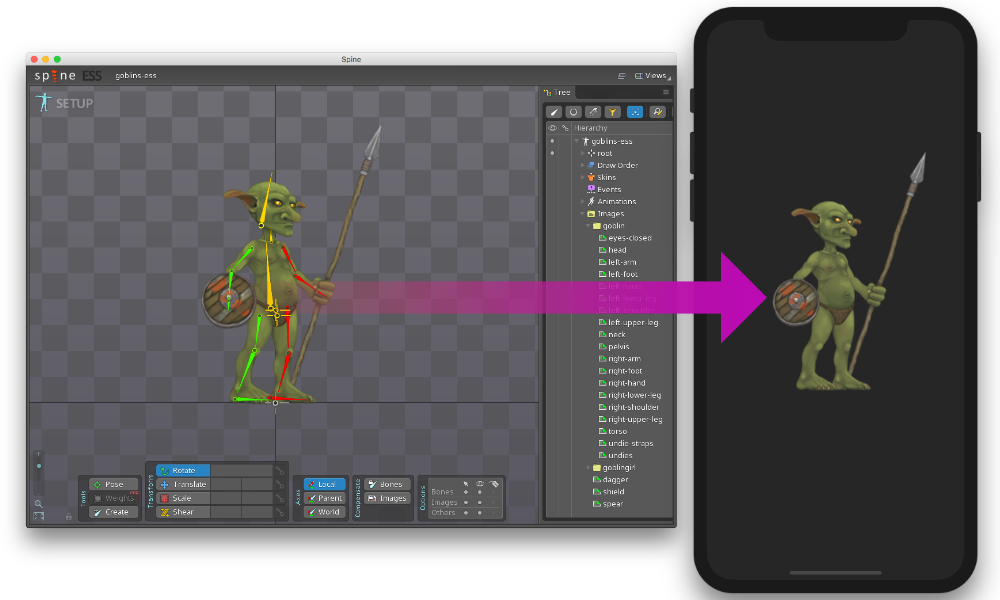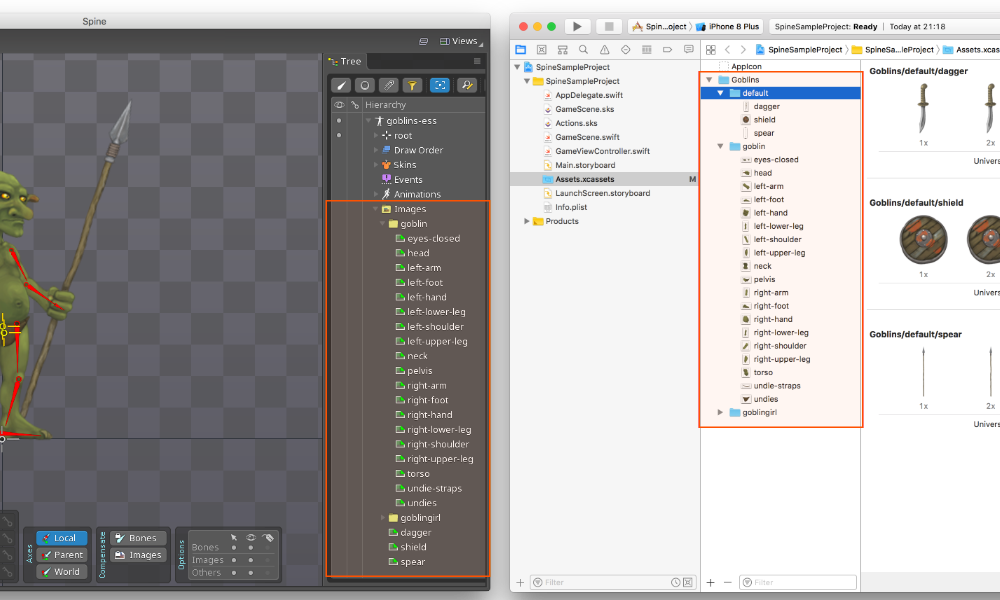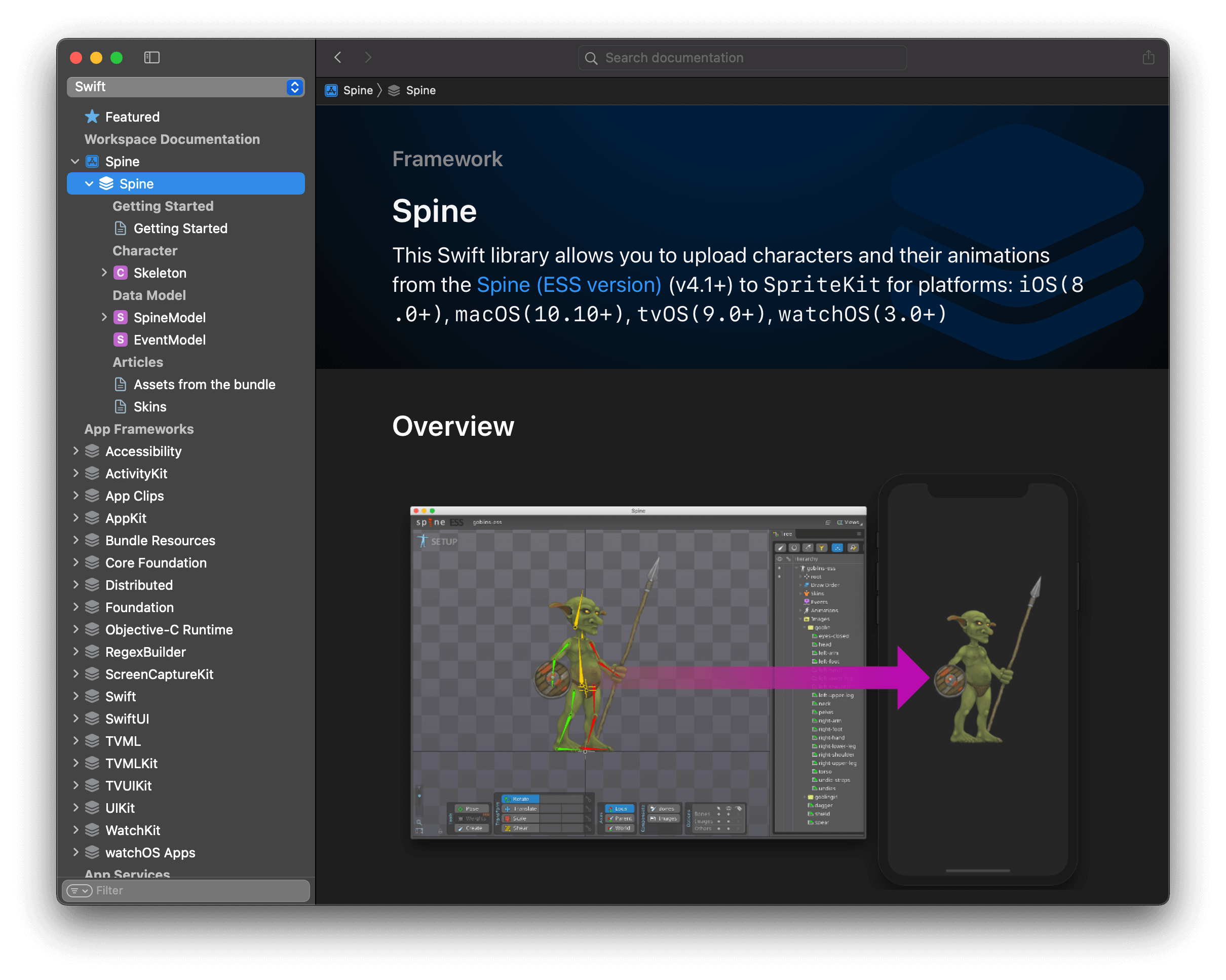Spine
This Swift library allows you to upload characters and their animations from the Spine (ESS version) (v4.1+) to SpriteKit for platforms::
iOS macOS tvOS watchOS
Implemented almost all the functionality of the essential version of Spine app: Animation of bones, skins, animation of slots, creation of physical bodies on the basis of bounding boxes and some other. See Implemented Features for more information.
Warning: There is no implementation of Spine Pro functionality and it is not planned. There are no such features as meshes and their animations. Moreover, when trying to load a character from Spine Pro version with meshes, it will not even be displayed correctly on the screen, a lot of textures will be missing.
Example of working with the library: Sample project
Learn more about working with the library: Spine Wiki
You can also compile the documentation in Xcode

Installing
Spine Library can be installed using Swift Package Manager.
Use the package URL to search for the URLImage package: https://github.com/maxgribov/Spine
For how-to integrate package dependencies refer to Adding Package Dependencies to Your App documentation.
Basic Usage
Assets
Files
- In
Assetscatalog createfolder. (Goblinsfolder in example below) - Create
sprite atlases. (default,goblinandgoblingirlsprite atlases in example below) - Put images into sprite atlaces.
Note: Note that the images that are in the
rootfolder of the Spine app project must be in the sprite atlas nameddefaultin the Xcode project.
Final result should looks something like this:

Namespace
Set Provides Namespace option enabled for the root folder and for all sprite atlases in the Xcode's attribute inspector:

Warning: If you forget to set the namespace, later when you initialize your character images can be just not found.
JSON
Put the JSON exported from the Spine application somewhere in your project:

For more information about assets see Assets Wiki
Code
Somewhere at the beginning of your code, import the Spine library:
import Spine
The easiest way to load a character from a JSON file and apply skin to it is to use the appropriate Skeleton class init:
let character = try Skeleton(json: "goblins-ess", folder: "goblins", skin: "goblin")
Skeleton is a subclass of
SKNode, so you can do with it whatever you can do withSKNodeitself
This way you can apply the animation created in Spine to the character:
let walkAnimation = try character.action(animation: "walk")
character.run(walkAnimation)
The
action(animation:)method returns an object of theSKActionclass so that you can use this animation as any other object of theSKActionclass
This is an example of the simplest scene in which we load our Goblin character, add it to the scene and start walk animation in an endless loop:
import SpriteKit
import Spine
class GameScene: SKScene {
override func didMove(to view: SKView) {
do {
let character = try Skeleton(json: "goblins-ess", folder: "goblins", skin: "goblin")
character.name = "character"
character.position = CGPoint(x: self.size.width / 2, y: (self.size.height / 2) - 200)
addChild(character)
let walkAnimation = try character.action(animation: "walk")
character.run(.repeatForever(walkAnimation))
} catch {
print(error)
}
}
}
Implemented Features
| Name | Model | Feature | Animation |
|---|---|---|---|
| Bones | |||
| - Rotation | + | + | + |
| - Translation | + | + | + |
| - Scale | + | + | + |
| - Shear | + | - | - |
| Bones extras: | |||
| - Reflect | + | - | |
| - Rotation Inheritance | + | - | |
| - Scale Inheritance | + | - | |
| - Reflect Inheritance | + | - | |
| Slots | |||
| - Attachment | + | + | + |
| - Tint Color | + | + | +/- |
| - Dark Tint Color | + | - | |
| Skins | + | + | |
| Attachments | |||
| - Region | + | + | |
| - Mesh | + | - | - |
| - Linked Mesh | + | - | - |
| - Bounding Box | + | + | - |
| - Path | + | - | - |
| - Point | + | + | |
| - Clipping | + | - | - |
| Constraints | |||
| - IK Constraint | + | - | - |
| - Transform Constraint | + | - | - |
| - Path Constraint | + | - | - |
| Events | + | + | + |
| Draw Order | + | + | + |
Documentation
The Spine library is pretty well documented. You can find the documentation both in the source code files themselves and compile the documentation for displaying it in the Developer Documentation in Xcode.
To compile the documentation use the menu: Product > Build Documentation
Or use a shortcut: ctrl + shift + command + D
As a result, the Developer Documentation will open and you will see something like this:

System Requirements
Swift 5.0
- iOS 8.0+
- macOS 10.10+
- tvOS 9.0+
- watchOS 3.0+
License
This project is licensed under the MIT License - see the LICENSE file for details
Useful links
- Spine user guide: http://esotericsoftware.com/spine-user-guide
- Spine JSON format documentation: http://esotericsoftware.com/spine-json-format
- Spine oficial runtimes: https://github.com/EsotericSoftware/spine-runtimes
GitHub
| link |
| Stars: 171 |
| Last commit: 16 weeks ago |
Related Packages
Release Notes
Swiftpack is being maintained by Petr Pavlik | @ptrpavlik | @swiftpackco | API | Analytics